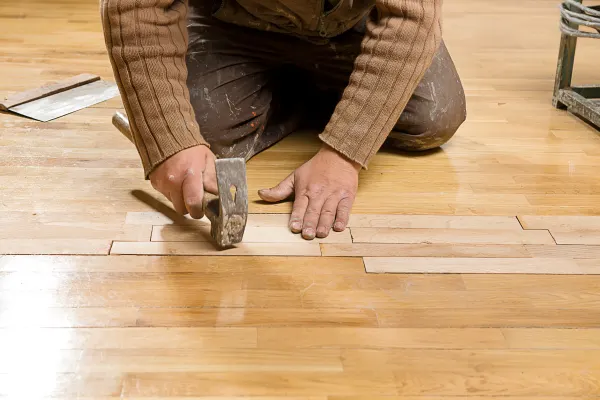Sound is an energy wave that travels through the air and solid materials. In multi-story homes, noise moves in two primary ways: through direct impact on surfaces and airborne transmission. The type of flooring in a home determines how these sound waves are absorbed, reflected, or transferred, affecting overall noise levels.
Impact noise occurs when an object physically contacts a surface, such as footsteps on hardwood or dropping items on tile. This noise vibrates through the structure, making it one of the most challenging types to control. Airborne noise, on the other hand, includes sounds like conversations, music, and television audio, which travel through the air and are absorbed or reflected by different surfaces.
Homes with hard, reflective surfaces often experience greater sound transmission than those with softer, more absorbent materials. High ceilings, open floor plans, and the absence of sound-absorbing materials like carpets or upholstered furniture can exacerbate noise issues.
Flooring materials play a crucial role in sound control. Some materials absorb sound effectively, reducing echoes and noise transfer, while others amplify sound, making footsteps and movement more noticeable. The right flooring can contribute to a quieter, more peaceful environment.
The Noisiest and Quietest Flooring Materials Compared
Choosing the right flooring for a multi-story home is not just about aesthetics or durability—it also plays a crucial role in managing noise levels. Some flooring materials amplify sound, making footfalls and dropped objects more pronounced, while others absorb noise, creating a quieter and more peaceful environment. Understanding which materials contribute to noise transmission and which help minimize it can significantly enhance the comfort and functionality of your living space.
- Hardwood Floors. Hardwood is visually appealing but notorious for amplifying noise. Footsteps, furniture movement, and dropped objects can create disruptive sounds, particularly in multi-story homes. Using area rugs or adding an underlayment beneath hardwood can help mitigate noise.
- Tile and Stone. Tile and stone flooring are among the hardest surfaces, making them highly reflective of sound waves. While they offer durability and a sleek aesthetic, they can cause excessive noise transfer. Adding rugs or using sound-dampening underlayment can help reduce echoes.
- Carpet. Carpet is the best flooring option for noise reduction. Its soft fibers absorb impact noise and airborne sound, making it ideal for bedrooms, hallways, and living areas in multi-story homes. The thickness and density of the carpet play a role in its sound-absorbing capabilities.
- Vinyl and Luxury Vinyl Plank (LVP). Vinyl flooring offers a middle ground between sound absorption and durability. It provides some cushioning, which helps reduce impact noise, making it a good option for reducing footstep sounds in high-traffic areas.
- Laminate Flooring. Laminate mimics the look of hardwood but tends to amplify sound due to its rigid surface. Without proper underlayment, laminate can be just as noisy as tile or hardwood. Using an acoustic underlayment can help reduce sound transmission.
- Cork Flooring. Cork is one of the best natural materials for sound absorption. Its cellular structure helps dampen sound waves, reducing both impact and airborne noise. It’s an excellent option for bedrooms and living spaces in multi-story homes.
- Rubber Flooring. Rubber flooring is commonly used in gyms and playrooms due to its superior impact absorption. It significantly reduces noise transfer, making it a great option for reducing sound in homes with active children or workout areas.
- Engineered Wood. Engineered wood offers the look of hardwood with better sound absorption, particularly when paired with quality underlayment. It is a practical choice for homeowners looking for aesthetics with improved noise control.
How Underlayment Affects Sound Control
Underlayment acts as a buffer between the flooring and subfloor, absorbing vibrations and reducing the transmission of impact noise. Different underlayment materials provide varying levels of soundproofing.
Best Underlayment Options for Different Flooring Types

- Foam underlayment: Ideal for laminate and engineered wood to minimize sound reflection.
- Cork underlayment: Adds excellent soundproofing beneath hardwood or vinyl.
- Rubber underlayment: Provides superior impact absorption for multi-use spaces.
- Felt underlayment: Enhances carpet sound absorption while adding insulation.
Pairing the right flooring with a suitable underlayment maximizes noise control. For example, installing cork underlayment beneath hardwood significantly reduces noise transfer between floors.
Additional Soundproofing Strategies for Multi-Story Homes
Beyond flooring choices, there are several ways to enhance soundproofing in a multi-story home. Combining different strategies can significantly reduce noise transmission and create a more peaceful indoor environment. Whether through structural modifications, acoustic materials, or strategic furniture placement, these additional soundproofing measures help manage both impact and airborne noise effectively.
- Using Acoustic Mats. Acoustic mats placed beneath flooring materials act as additional noise barriers, reducing vibrations and sound travel.
- Installing Soundproofing Barriers Between Floors. Adding soundproofing insulation between floor joists minimizes airborne noise transmission between levels.
- Using Rugs and Carpets. Strategically placing rugs in high-traffic areas significantly reduces footstep noise, enhancing overall acoustic comfort.
- Sealing Gaps and Cracks. Even small gaps in flooring and walls can allow sound to travel freely. Sealing these spaces with acoustic caulk or specialized soundproofing materials prevents noise leakage.
Flooring Considerations for Different Household Needs
Carpet, cork, and rubber flooring provide excellent noise reduction, durability, and comfort for households with children and pets. Selecting quiet flooring materials is essential in shared living spaces to prevent disturbances and maintain privacy. For home offices, carpet, cork, or vinyl flooring helps maintain a quieter work environment by absorbing noise. Durable yet sound-absorbing options like LVP, cork, and carpet provide long-lasting noise control for rental homes and busy households.
The Cost vs. Benefit of Soundproof Flooring Materials
Considering long-term benefits such as improved comfort, privacy, and property value, soundproof flooring is often a worthwhile investment. Homeowners should weigh the cost of flooring materials against their ability to reduce noise while maintaining a visually appealing design. If noise complaints, sleep disturbances, or privacy issues arise, upgrading to soundproof flooring can significantly enhance the home environment.

